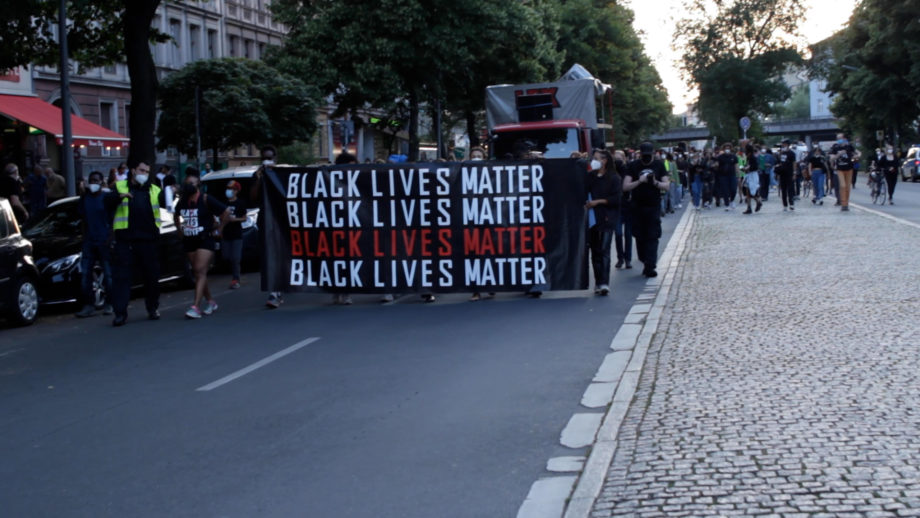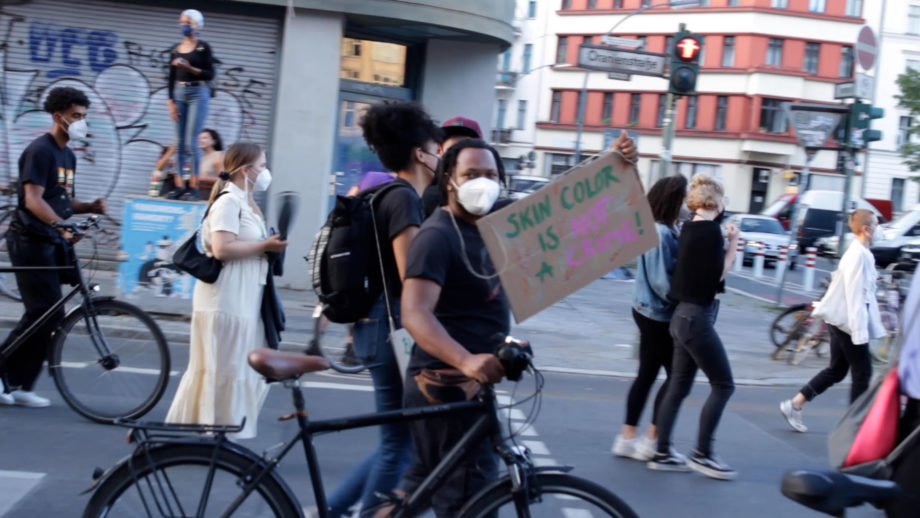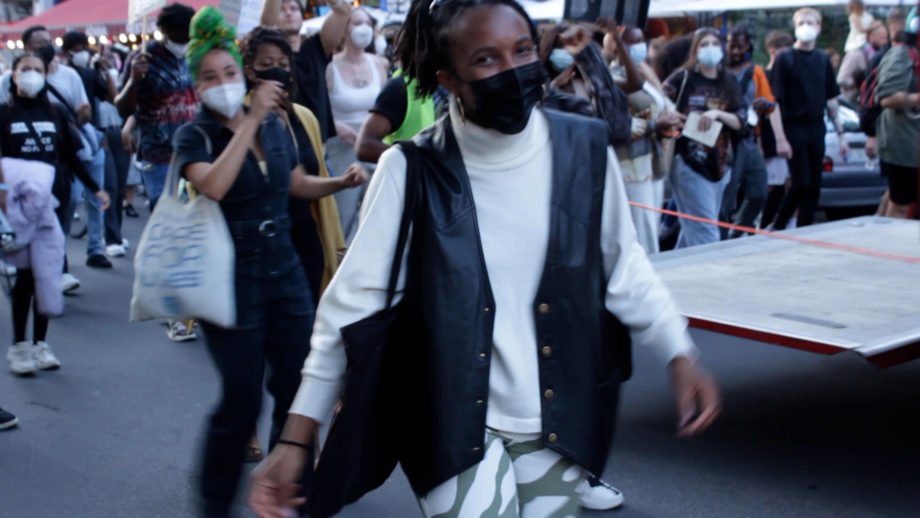Calling Worlds into Being
The Sound of Black Lives Matter
 BLM Banner
BLM BannerBlack Lives Matter!…Black Lives Matter!…..Say it loud…. I’m Black and I’m proud! ……I’m Black and I’m so fucking proud!” (BLMB demo 2021)
It’s been years now since I heard this chant at the Black Lives Matter demo in Berlin in 2021. Since then, the whole world has once again turned on its head. But still, it is a chant that is prescient, powerful, urgent and necessary to repeat again. It is a phrase that needs to be embodied and held, a mantra to guide not only our thoughts but feelings. Black Lives Matter is a global movement responsible for mobilising millions, and in turn elevating Black led movements everywhere. I am considering ‘movement’ here as not only that which ‘moves’ us consciously end emotionally but also the work of activism, that action to affect and make change. Change not necessarily on a global scale, but ‘doing the work’ of making structural racism visible, the work of naming, and the work of claiming that which has been systemically denied. ‘Black Lives Matter’ as a banner helps connect disparate but mobilised communities through naming the central desire for Black lives to matter, highlighting that they still don’t, but that they matter to us, and by ‘us.’ I am conceiving of those fully engaged in this struggle, where ‘mattering’ means allowing our lives and the lives of those we love, those we know, those we don’t know to collectively matter too.
In saying ‘Black Lives Matter,’ I am not just repeating a ‘phrase’ or a ‘slogan’ I am thinking about what these words feel like and mean to me as a member of the African diaspora in Germany. The chant and statement that heads this piece, written here as ‘words,’ does their spoken weight no justice. Writing, with all the poetics I can muster can only approximate their complexity, but it can never convey the passion I heard in the need and the want for the call for Black life to matter, to be true. Instead, it is an intention, a need and a demand that was heard and felt through the vibratory sonic encounter of the ‘call and response’ performed at the demo.
Therefore, it is the sonic that I want to proceed from, not just the content of what is said and heard, but what is felt, invoked, evoked, and embodied in the sounds and soundscapes that emerge in the transformative space of the Berlin, BLM demonstration. I make no claim about other BLM demonstrations elsewhere, although undoubtably there are parallels. Rather for this purpose I am drawing on my participation in the annual BLM demo in Berlin as an organizer and crew member. The demo in my experience can feel like an almost utopic microcosm where a radical imagination is performed, one reflected in the title of this piece, ‘Calling worlds into being.’ The ‘Call’ is an action and invocation that has prompted the questions; what are we calling into being? What is undone and remade in the ‘call’ and the ‘response’? And what are the imaginary and material repercussions of this fugitive wish, this prayer, this claim, this ‘call’ that we throw out into the air, that we release from deep inside us?
There is not the space to answer all these questions here. But I want to consider instead some of the ways in which the sonorous and embodied articulations of the demo become transformative, and how such transformation can call in change. In thinking of sound, I want to qualify that my use of the term includes ‘noise ‘ and how it functions “as a way of disrupting a perceived status quo” (Schramm, Krause, and Valley 2018, 251) and extends to not just the heard, but that “felt sound,” (Campt 2017, 13) sound that registers as vibration activating the body, mind and releasing emotions in various formations. There are many layers contributing to the sonic atmosphere (Eisenlohr 2018) at a BLM demo such as; whistles, bells, voice, movement, the police, traffic and music in the form of live performances and the sound-system that accompanies and leads the demos’ procession through the centre of Berlin, from the Mitte business district to the historically migrant neighbourhood of Kottbusser Tor, south of the centre. In doing so, the demo creates a mobile soundscape, forming a sonic and phonic topography that is shaped through contact and proximity to the embedded histories of the city and the bodies which form the demo every year with the sounds they make and bring. One of the most urgent sounds at the demo is that which extends the vocal range, the ‘chant.’ The chant, which is performed as ‘call and response,’ heralds our arrival, precedes and recedes us, makes claims and challenges socially and sonically inscribed norms. I want to think here about what ‘that’ sound does, its content and how its production creates a space for potential transformation.
 Skin color is not a crime.
Skin color is not a crime.“Black trans-lives matter, Black drag lives matter, Black kids matter, Black dreams matter, Black hopes matter, Black culture matters, Black dreams matter, Black future matters, Black ideas matter, Black businesses matter!” (BLM demo 2021)
Like all chants at the BLM demo, this chant is significant, it is so, not only for what it imagines but the ways in which it points to a present and a future. It functions on multiple registers and is more than a proclamation that Black life matters. What occurs in this extended chant, which begins by calling forth the notion of precarity through foregrounding[1] Black trans-lives, shifts register to open a up a space of possibility, refusing the finality of death in its continuation for trans-lives, drag, kids, dreams, hopes, culture, futures, ideas, and Black businesses to matter. It is, to borrow from Tina Campt, a claim to a “futurity” (2017) where these words like wishes ignite the possibility to imagine an otherwise existence. By positioning Black lives alongside hopes and dreams, even dreams of financial security, it is a way of calling a different world into being.
This chant troubles the notion that Black life is synonymous with precarity and death through its unabashed confidence that Black ideas, dreams, and futures should matter, those ephemeral desires, thoughts and feelings that become the force that perpetuates motion. To excavate this further Ashon T. Crawley asks; “what happens when we bring enunciation close, make the concept rub up against, fugitivity, two terms moving, seemingly, in antithetical directions?” (2016, 36). The chant embodies this inherent tension, calling forth injustice whilst simultaneously calling forth hope, a hope which is ‘fugitive.’ Crawley argues that “such releasing becomes the grounds from which to be enfleshed anew, to announce an otherwise desire than what is normative. The fugitive enacts by enunciative force, by desire, by air, by breath, by breathing” (2016, 36).
I want to call Crawley’s notion of becoming “enfleshed anew” what it is: transformation, to be remade, to be transformed not only at the register of intellect, or emotion, but of the body. The performance of this chant, through voice, breath and body is the site of this remaking, and as such, I return to the question; what does this chant feel like? That “felt sound”(2017, 13) which Campt encourages us to recognise, the hum and vibration that unleashes the archive stored in the muscle and bone that is ‘released’ in the production of the chant, that enunciative breath, a sound which vibrates the body with potential and meaning. This transformation is experienced as not only a tonal shift as we enfold those words into us, but the desire which radiates from their intention generates a sense of rising, in and of the chest, that same spot where weight is felt in its contrary. A physical release that is quite literally uplifting, it does so not by negating the experiences of racism and marginalisation. Rather, by making us complicit in naming the desire to have a full life, one not defined by struggle and resistance but by our ‘hopes and dreams,’ it is a chant that works to affirm, and in doing so, makes space for living![2] This ’space’ that Katherine Mckittrick has termed ‘Black Livingness’ (McKittrick 2021) is a register which is reparative and restorative, made manifest in and through those practices, modalities and desires which re-centre Black ways of knowing and being.
As such, this heard and felt sound can be transformational, but Brandon LaBelle in his work on acoustic justice (2020) as well as Tina Campt (2017) who is instrumental in moving our conception of sonic articulations, both warn us of the attention paid to ‘heard’ sound, which not only privileges the ‘hearing world’ but limits our understanding of sound. Therefore, I want to conclude by considering the kinetic embodiment of sound at the BLMB demonstration in dance.
 Joy at the BLM demo
Joy at the BLM demoThere are countless moments at the demo that could illustrate this imbrication, but none more profound than the spontaneous gathering that occurred at the end of the 2021 Demo at Spreewald Platz, in Berlin. A small square that marks the end of the demo journey and where the final speeches and musical performances are held. When I arrive, Dancehall is shaking the ground, people are lost in the music. A large group of around 30 people have drawn together as close as possible to the stack of speakers on the side of the truck. The speakers’ vibrations create a magnetism, which in turn propels the sound through the body as “accelerant” and “amplification” (Henriques and Ferrara in Stratton and Zuberi 2016). They are locked onto each other, all eyes connecting, communicating beyond words seen in the shift of movements that mirror, compliment, and reflect the music and sounds they are feeling and each other. There is a release in the extension and elasticity of their limbs, people rolling and flexing like water. Bodies rising and falling to the beat of the music. Creating a temporal disturbance through the warping of time found in the aural and embodied registers which we welcome as overwhelming immersion. Soon a semi-circle is formed, signalling the stage and the space for self-expression, this is the point where the transformation that has already occurred becomes explicit, a transformation made in the vibrating crucible of bodies that have atomized liberation and a radical imagination in the extension of their movements and in the sweat on their skin.
What this scene demonstrates is that dance and sound are prefigurative practices that call a different world into being. Where eruptive practices and expressions that centre both joy and life create powerful openings. At the start of this piece, I asked; what are the imaginary and material repercussions of this ‘calling’? And I find my response here, in this multisensory encounter with the transformative power of a sonic force articulated not just in the voice and the breath, but in the vibratory resonance of dance as a performance of liberation. What these encounters ‘do’ is produce reverberations in the days, weeks and years that follow. The BLM demo and its sonic articulations create a space of possibility and for a moment we collectively experience an eclipse of the world we have with the world we want.
‘Joy’ is a sound and Image piece that meditates on the anti-gravitational capacities of dance as ‘Refusal.’ It is made with footage from the Berlin BLM demo in 20201 and includes sounds from the demo and across the African diaspora. Film by Melody Howse, Camera by Solomon Mekonen
Footnotes
[1] 2021 marked a rise in the number of deaths among the Black transgender community with 48 deaths in the USA be the end of the year. One of those people was Tony McDade who was killed a month before the BLMB demo and his death was reflected in the chant. Link to articke: https://www.theguardian.com/world/2021/jun/14/us-trans-transgender-deaths-2021
[2] In cross community settings such as the BLMB demo the languages of communication are primarily German and English. Many of the of chants are in English reflecting their North American origin although a number of chants are always spoken in German likewise mirroring origin.
References
Campt, Tina. 2017. Listening to Images. Durham: Duke University Press.
Crawley, Ashon T. 2016. Blackpentecostal Breath: The Aesthetics of Possibility. Fordham Univ Press.
Eisenlohr, Patrick. 2018. ‘The Work of Transduction: Voice as Atmosphere’. https://doi.org/0.1515/9780520970762.
LaBelle, Brandon. 2020. Acoustic Justice: Listening, Performativity, and the Work of Reorientation. Bloomsbury Publishing USA.
McKittrick, Katherine. 2021. Dear Science and Other Stories. Errantries. Durham: Duke University Press.
Schramm, Katharina, Kristine Krause, and Greer Valley. 2018. ‘Introduction: Voice, Noise and Silence. Resonances of Political Subjectivities’. Critical African Studies 10 (3): 245–56. https://doi.org/10.1080/21681392.2019.1610013.
Stratton, Jon, and Nabeel Zuberi. 2016. Black Popular Music in Britain Since 1945. Routledge.
Melody Howse is an Interdisciplinary Researcher, filmmaker and writer from Belize & UK. She received her Master’s in Visual and Media Anthropology at the Freie Universität Berlin in 2016. And is currently completing a PhD in Anthropology at the University Leipzig where her doctoral thesis focuses on racial encounters and the body. Alongside pursuing a PhD Melody works as a community researcher lending her skills in research, writing and video production to Black led organisations in Berlin.































